R.W. Hammon and C.H. Pearson* (2/14)
Quick Facts…
- Western whorled is a common plant native to the western U.S. and Mexico which becomes a troublesome weed when it invades pastures, hay fields, orchards, gardens, ditch banks, roadsides, fence rows, and other sites. Invasion prevention by using good cultural practices is especially important. Once established, western whorled milkweed can be difficult to control.
- It can be highly toxic to many species of livestock and is a common plant found in the lower elevations of Colorado and surrounding states.
- There is no specific treatment for milkweed poisoning. Animals that consume a sublethal dose should recover within a few days.
- If an animal is known to have consumed western whorled or other milkweeds, it should be moved from the plant source, given fresh water, good quality hay, and shelter.
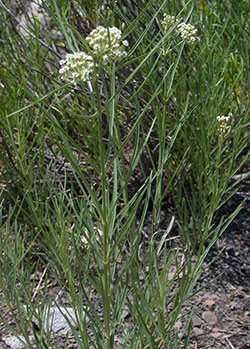
Figure 1. Western whorled milkweed is a distinctive plant with upright growth habit, narrow leaves, and round inflorescence of greenish-white flowers. Photo by M.E. Harte. |
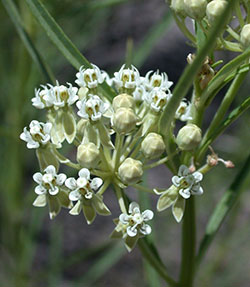
Figure 2. Milkweed petals are in two 5-parted whorls with the inner modified into a horn-like projection. Pollen is formed in waxlike masses called pollinia. Photo by M.E. Harte. |
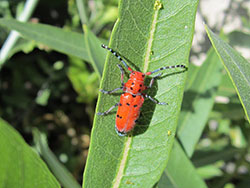
Figure 3. Red milkweed beetles are specialists on milkweeds. Their bright red aposomatic coloration warns predators to stay away. Photo by: R.W. Hammon. |
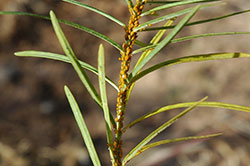
Figure 4. The bright yellow oleander aphid is commonly found on western whorled milkweed. It sequesters secondary toxins from the plant which make it almost immune from predators although parasitic wasps attack it. Photo by R.W. Hammon. |
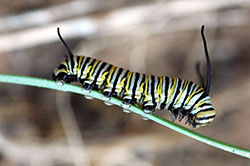
Figure 5. Larvae of monarch butterflies feed exclusively on milkweeds. The colorful caterpillars are poisonous to birds, which learn to recognize and avoid them. Photo by R.W. Hammon. |
Western whorled milkweed (Asclepias subverticillata) is a common plant found in the lower elevations of Colorado and surrounding states. While it is native to the western U.S. and Mexico, it becomes a troublesome weed when it invades pastures, hay fields, orchards, gardens, ditch banks, roadsides, fence rows, and other sites. It can be highly toxic to many species of livestock.
Western whorled milkweed is a perennial, reproducing both by seed and from roots. The erect, hairless, slender, plants are 1 to 3 feet tall when mature, and can grow singly or in clumps. The narrow leaves, about 3/8” wide and up to 5” long, grow in whorls of 3 to 5 at each node. The umbrella-like cluster of greenish-white flowers appear in mid to late summer at the top of branches and in leaf axils. The 3-5” long, narrow seed pods open along seams to release numerous flat brown seeds that are 1/5” long with a feathery tuft of silky hair. Stems and leaves contain a milky latex which oozes from veins when cut or broken.
Western Whorled Milkweed as a Poisonous Plant
All milkweeds are poisonous to some degree to all classes of livestock including poultry. Poisoning is not uncommon in sheep and cattle, and occurs occasionally in horses, goats, alpacas, and rabbits. Ingestion usually occurs with over grazing or hay contamination. Many poisoning incidents in livestock occur when hungry animals are concentrated in milkweed-infested areas or when animals are fed milkweedcontaminated hay.
Western whorled milkweed contains mostly uncharacterized neurotoxic compounds that are toxic to livestock. The broad-leafed milkweeds or those that do not have whorled, narrow leaves contain cardenolides—potent heart poisons— while other glycosides and resinoids affect respiratory and digestive systems when ingested.
The narrow-leaved species such as western whorled are among the more toxic milkweed species. An average-sized sheep is likely to die after eating as little as 1 to 4 ounces of green leaves of western whorled milkweed. Mortality can occur as soon as a few hours or as long as a 2 to 4 days after ingesting the plants.
Two clinical manifestations of poisoning have been reported: 1) digestive tract/cardiac type, and 2) a neurological type. The cardiotoxic effect is often lethal.
Symptoms of poisoning include shortness of breath, colic, diarrhea, muscle tremors, seizures, incoordination, and/or head pressing. Clinical signs of milkweed poisoning usually begin with weakness, labored breathing, ataxia and loss of balance. Symptoms progress to the inability of animals to stand, seizures, and death.
Milkweeds are most toxic during periods of rapid growth, and retain their toxicity even when dry. All parts of the plant are poisonous. Western whorled milkweed is not very desirable or palatable to most livestock, but animals will eat it when other feed is in short supply. Poisoning can occur when western whorled milkweed is mixed in with dried hay and fed to animals that can’t separate it from the more desirable components of the hay.
There is no specific diagnosis for milkweed poisoning. The only way to diagnose it with certainty is through post-mortem identification of plants in the animal’s stomach and food source.
There is no specific treatment for milkweed poisoning. Animals that consume a sub-lethal dose should recover within a few days. If an animal is known to have consumed western whorled or other milkweeds, it should be moved from the plant source, given fresh water, good quality hay, and shelter.
Insects that Feed on Western Whorled Milkweed
Several species of insects feed on milkweeds, with many of those developing bright red or yellow coloration. Many of these sequester the secondary compounds—such as cardiac glycosides—to protect themselves from predators, then develop bright aposomatic coloration to ‘advertise’ the fact that they are poisonous. None of the milkweed insects do more than minor damage to western whorled milkweed except in extreme circumstances.
Several species of milkweed longhorns or red milkweed beetles, Tetraopes spp. can be found on milkweed plants during the summer months. Larvae of these beetles feed on roots of various milkweed species.
Yellow milkweed aphids, also known as oleander aphids, Aphis nerii, are commonly found on milkweeds in mid-summer through fall. Western whorled milkweed is a particularly good host plant for the aphid. Aphid populations can reach high levels, but they apparently do little damage to the plants.
Monarch and Queen butterflies utilize milkweeds, including western whorled milkweed as larval host plants. Recent publicity focusing on conservation of these beautiful insects has encouraged planting of milkweeds as a food source for migrating butterflies. One should be cautious about planting potentially poisonous weeds too close to pastures, hay fields, or other sites where it can cause problems from ingestion by animals.
Managing Western Whorled Milkweed
Problems related to poisonous milkweeds date back to at least the early 1900s (May, 1923) and managing/controlling this problem weed was suggested for that time. As expected, a management program of today for western whorled milkweed is much different than in the 1900s.
The specific goals of the landowner must be considered when developing a present-day management plan for western whorled milkweed. Obviously, management for conservation of monarch butterflies is different than management to prevent livestock poisoning on milkweed infested pastures.
Correct plant identification and knowledge that the plant is present in pastures or hay fields are important initial steps in developing a management plan for western whorled milkweed.
The most preferred approach to avoid animal poisoning is to use management practices that prevent ingestion. Avoiding poisoning can be accomplished in two major ways: 1) preventing ingestion in the field, 2) avoiding ingestion from contaminated hay. Fields containing western whorled milkweeds should not be cut and used for hay. When purchasing hay make sure the hay is not contaminated with milkweeds. Know the source, and use the necessary means to verify the quality of the purchased hay.
Preventing western whorled milkweed from invading gardens, landscaping, roadsides, pastures, and fields by using good cultural practices is especially important. Proper grazing management in pastures is essential to preventing western whorled milkweed from invading. Once established, western whorled milkweed can be difficult to control.
Hand weeding, mowing, and tillage during the growing season are largely ineffective in controlling western whorled milkweed because of its extensive root system. Effective controls must kill the root systems so plants cannot send up new stems after top growth is eliminated.
Herbicides can provide effective control, but choosing the best product is dependent on the situation the treatment is to be applied to. The area to be treated, time of year, surrounding vegetation, crop, and future land use are some of the issues that must be considered before making control choices.
Always read and follow label directions when using any pesticide. Herbicides and herbicide combinations that can provide control of western whorled milkweed include:
Glyphosate–many products sold under numerous trade names for both home-use and commercial markets. Glyphosate products are good for spot treatments when there is no desirable vegetation in the sprayed area because it is a non-selective herbicide. Use at upper end of label rates, flowering through maturity growth stage.
2,4-D plus Dicamba–The combination of the two active ingredients is more effective than either alone. This combination will kill or damage most broadleaf species that come in contact with the spray or drift, so it cannot be used when there are desirable broadleaf plants in the targeted area. Many products and formulations are available on the home-use and commercial markets. Use rates vary with product. Many product labels have instructions for the tank-mix rates of this combination. Application at flower bud to bloom stage is most effective. Beware of use in high temperature, low humidity conditions.
Perspective–a combination of aminocyclopyrachlor and chlorsulfuron, has been shown to be effective at a rate of 5.5 oz of product per acre. This product controls many perennial broadleaf plants but not grasses at this rate. Perspective is labeled for use on non-agricultural lands only and is available only in commercial sized packaging.
Tordon 22K (picloram)–is effective against western whorled milkweed in grass pastures, fallow cropland and many non-crop areas. Use rates vary with application site. Tordon 22K is a restricted use pesticide available in commercial packaging only to licensed applicators.
Always carefully and thoroughly read and follow label directions when using any pesticide.
Selected References
May, W.L. 1923. Control of the whorled milkweed in Colorado. Bulletin 285. Experiment Station. Colorado Agricultural College. Fort Collins, CO. 24p.
Panter et al., 2012, Poisonous Plants of the United States: In Gupta, R.C. ed. Veterinary Toxicology, Basic and Clinical Principles, Academic Press, New York, p. 1031-1079.
Whitson, T.D., L.C. Burrill, S.A. Dewey, D.W. Cudney, B.E. Nelson, R.D. Lee, and R. Parker. 1991. Weeds of the West. Western Society of Weed Science, Western United States Land Grant Universities Cooperative Extension Services, and the University of Wyoming. Printer-Pioneer of Jackson Hole. Jackson Hole, Wyoming.
Zimdahl, R.L. 1983. Weeds of Colorado. Colorado State University Extension. Fort Collins, CO. p.115.
*R.W. Hammon, Colorado State University Extension agronomy & entomology agent, Colorado State University Western Colorado Research Center; C.H. Pearson, professor. 2/14.
Go to top of this page.




